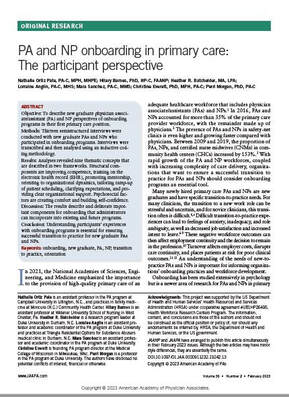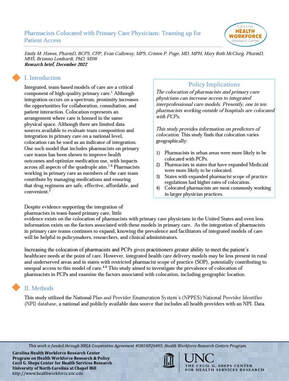The Health of US Primary Care: 2024 Scorecard Report — No One Can See You NowGrounded in the recommendations of the 2021 National Academies of Sciences, Engineering, and Medicine (NASEM) report, Implementing High Quality Primary Care: Rebuilding the Foundations of Healthcare, 8 this year’s Scorecard report assesses the health of primary care at the federal level using measures of access, financing, workforce/training, and research. This assessment identifies five reasons why primary care in the United States is inaccessible for so many Americans.
|
Pharmacists Co-Located With Primary Care Physicians: Understanding Delivery of Interprofessional Primary CareDespite evidence supporting the integration of pharmacists in team-based primary care, little information exists on the co-location of pharmacists with primary care physicians in the United States, and even less information on the factors associated with these models in primary care.
This article analyzes the degree to which pharmacists are co-located with primary care practices and characteristics associated with co-location. |
Better Primary Care: What Will It Take to Get the U.S. to Wake Up to the Need?
U.S. spending on primary care fell again, to a mere 4.6% of total health care dollars spent. Primary Care Collaborative is the only national multi-stakeholder organization focused on whole-person primary care. Primary Care Collaborative President & CEO Ann Greiner joins hosts Mark Masselli and Margaret Flinter to discuss better compensation and reimbursement for primary care clinicians and efforts to increase training, expanding access to community health centers, and opportunities for primary care to help as the country faces a mental health crisis.
Subsidizing doctor travel would aid rural health care access, study shows |
Rural Physician & Advanced Practice Provider Compensation Survey Results |
|
As Iowa faces workforce shortages in nursing and other areas, a new University of Iowa professor-led study has shed light on a possible tool to combat predicted losses in rural specialty health care
|
This first-of-its-kind survey provides a path forward for rural healthcare organizations by outlining provider compensation trends, best practices, and potential challenges leaders might face when recruiting and retaining top talent in rural healthcare.
|
New study shows benefits of paying doctors to go to rural Iowa |
Stressed Out and Burned Out: The Global Primary Care Crisis |
|
Instead of hiring more doctors to practice in declining rural areas, an easier way to solve Iowa's healthcare shortage might be to incentivize them to travel, according to new research from the University of Iowa.
|
Findings from the 2022 International Health Policy Survey of Primary Care Physicians
|
The Shrinking Number of Primary Care Physicians Is Reaching a Tipping Point |
CONNECTION IS RETENTION: Lessons from Leaders with Unusually High Nurse Retention |
|
The percentage of U.S. doctors in adult primary care has been declining for years and is now about 25% — a tipping point beyond which many Americans won’t be able to find a family doctor at all.
|
Crucial Learning and The American Organization for Nursing Leadership (AONL) surveyed 1,559 nurse managers and 562 clinical staff in March 2023 to identify drives of nursing turnover and retention.
|
Rural Pharmacies Provide Multi-Faceted Value to Rural Communities
Rural community pharmacies are often vital sources for prescriptions, vaccinations, patient education, and other healthcare needs, but the RUPRI Center for Rural Health Policy Analysis reported a decrease in the number of rural pharmacies from 2003 to 2021. A pharmacy chain in the Midwest, a pharmacy-based research network in the South, and an Illinois school of pharmacy discuss the rewards and challenges of operating in rural areas. This article features NuCara pharmacies located across Iowa and founded by TJ Johnsrud, a former IRHA Jerry Karbeling award winner. Read the full article, written by IRHA Board Secretary Whitney Zahnd, in The Rural Monitor here.




